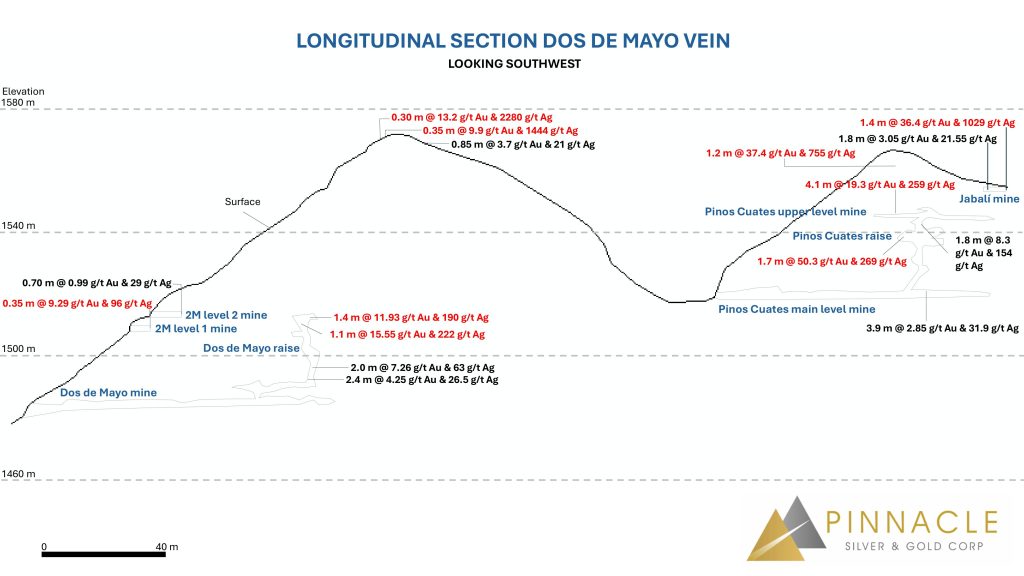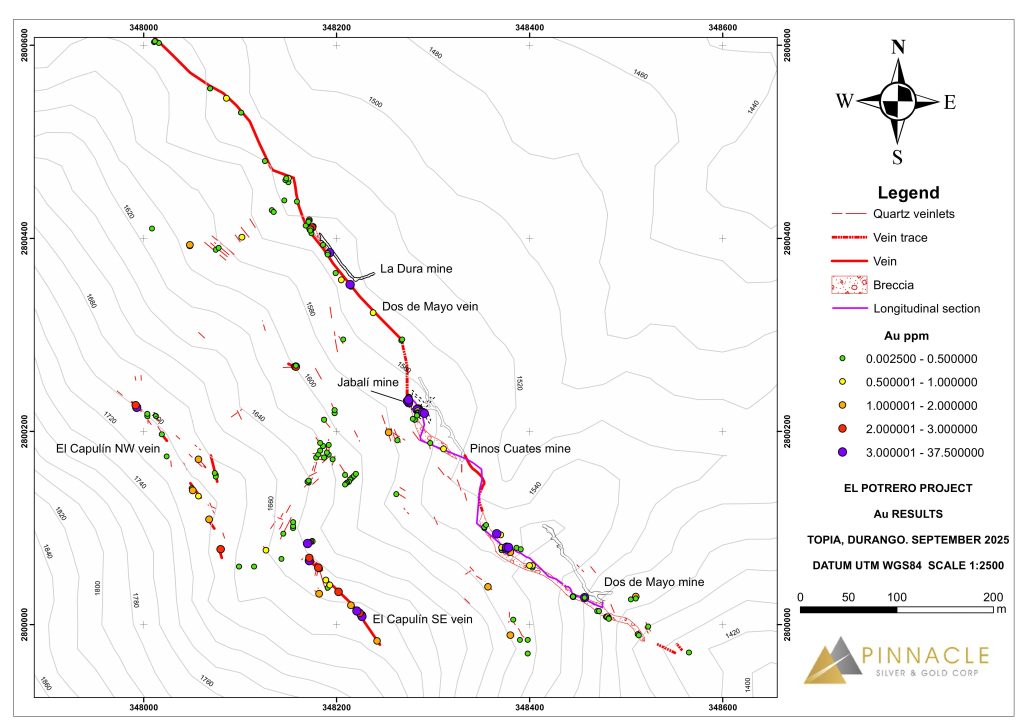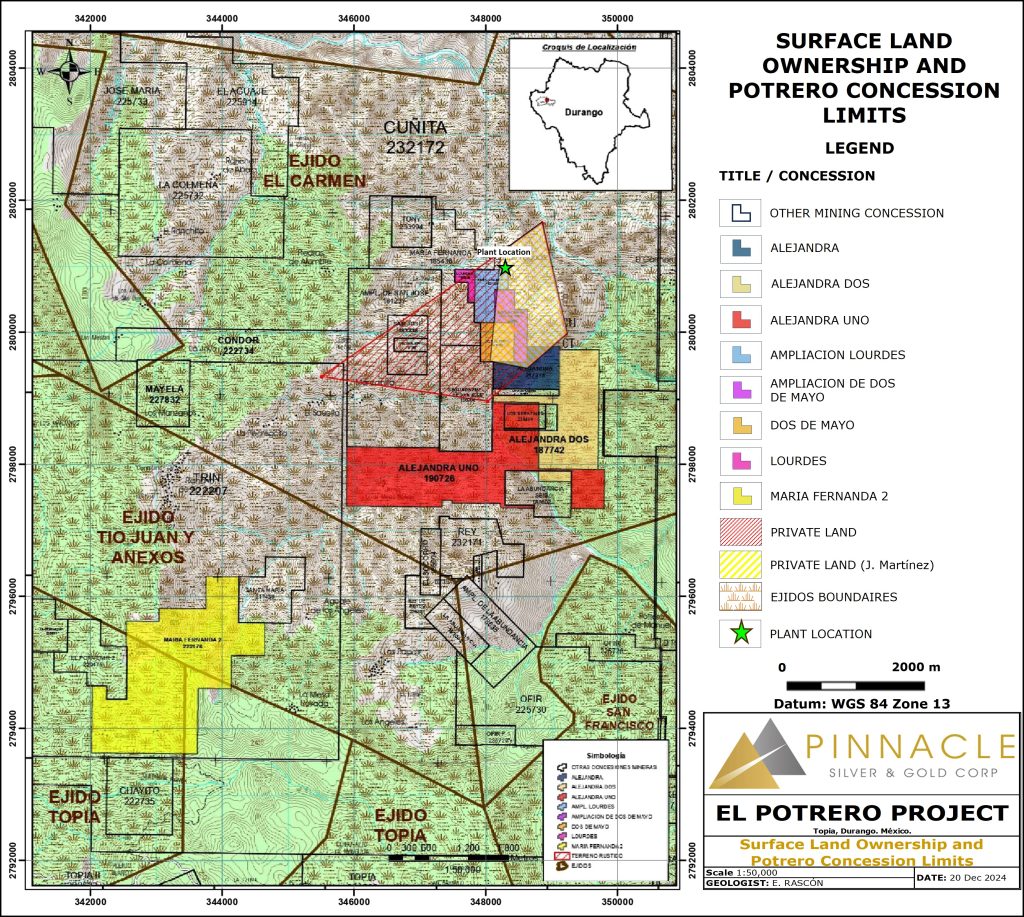El Potrero Project
The Potrero Project hosts a high-grade gold-silver vein system and lies within the Sierra Madre Occidental, a well-known trend of silver and gold deposits running down the western side of Mexico. The belt measures roughly 1,200 km long by 200 to 300 km wide and is one of the most prolific gold-silver belts in the world, hosting many world-class mines.
The project lies within a well-known and high-grade polymetallic mining district with four producing mines within 35 kilometres. Three historic artisanal underground mines on the property fed a 100 tonne per day (“tpd”) plant that was in operation in the late 1980’s. No systematic exploration or development has been conducted on the property since.
Potrero is road accessible, being about 8-9 hours drive from the city of Durango. It can also be reached by flying into Topia, the closest town, about 30 km away by road. A power line comes within 3 km of the project. Although the regional terrain is quite rugged with elevations reaching 2700m AMSL, the plant and historic mines are at an elevation of about 1370-1400m, similar to Topia. UTM coordinates for the property are approx. 348230 E, 2800830 N and it consists of 1,074 hectares in 8 concessions, seven of which are contiguous.
The largest mine in the region is Fresnillo’s La Cienega, a silver-gold-lead-zinc underground mine, in operation since 1995 and running at 4,000 tpd. It is about 35 km in a straight line to El Potrero and ‘on trend’ to the SE. El Potrero is surrounded by Fresnillo’s concessions. Topia is home to a silver-lead-zinc-gold underground mine built by Peñoles (now Fresnillo) in 1952 that was brought back into production in 2006 by Great Panther Silver. It is now owned by Guanajuato Silver and operates at about 250 tpd. The Tahuehueto Au-Ag-Cu-Pb-Zn Mine, operated by Luca Mining at 1,000 tpd is also about 15km to the NW from the project. Significantly, the vendor of El Potrero also owns and operates a 150 tpd Ag-Pb-Zn underground mine, called San Geronimo, approximately 25 km south of El Potrero. In short, the property is in a well mineralized district and on trend with one of the largest underground Au-Ag mines in Mexico.
Gold-silver mineralization at El Potrero is classified as low-sulphidation epithermal, with NW-SE vein breccias dominating in a typical system of braided or anastomosing veins covering a strike length of at least 2km. The host rock appears to be mostly andesite flows, breccias and tuffs within a window of the Lower Volcanic Series. Boxwork textures, and vuggy and chalcedonic silica are common. Although the rock is oxidized near surface, there are very fine sulphides present suggesting that fine pyrite might prevail at depth.
Three historic artisanal mines exist within approximately 500 metres of strike length along the vein system. Ground conditions are generally good and most of the adits are accessible. They have been rehabilitated from a safety perspective to allow systematic surveying, mapping and sampling to be carried out. The Pinos Cuates and La Dura mines each have about 75-100m of development, while the Dos de Mayo mine is reported to have been developed on 3 or 4 levels.
Importantly, this appears to be a high-grade system with reported head grades at the plant being in the range of 7-8 g/t Au and 170-200 g/t Ag or about 10 g/t Au equivalent. Vein widths underground are approximately 2 metres and reported to reach up to 8-10 metres. A historic resource estimate of 45,561 tonnes at 8.0 g/t gold and 186 g/t silver, as reported in a 2020 presentation provided by the vendors, was reportedly derived from underground sampling and production records, none of which are currently available. These resources are historical in nature and Pinnacle is not treating these estimates as current mineral resources as a qualified person on behalf of Pinnacle has not done sufficient work to classify them as current mineral resources.
Channel sampling of mineralized veins containing grey-black ginguro bands (very fine grained silver-gold mineralization) in the Pinos Cuates Mine has returned bonanza grades of up to 85.1 g/t gold (Au) and 520 g/t silver (Ag), higher than the historic production grades reported verbally by the vendors, and the historic resource estimate. See Pinnacle News Releases for June 2 and July 22, 2025.
The vendor has owned the property for decades and built the plant about 35-40 years ago. However, it only operated for 1.5-2 years. Pinnacle has cleared and cleaned up the facilities and surrounding area and, while the basic infrastructure is in good shape, most or all of the machinery and moving parts, electrical, etc. will need to be replaced. The plant is a fairly standard 100 tpd facility with primary jaw crusher, and two secondary cone crushers (all closed circuit with a screen), a small ball mill and regrind mill, thickener, cyanide vats and Merrill Crowe circuit.
There will be a number of permits required to put this back into production, but these can be initiated even as we are proceeding with the plant refurbishment, mine rehabilitation, etc. such that it may be possible to be in production by 2027.








































